| |
The shifting age distribution of people with HIV using antiretroviral
therapy in the United States, 2020 to 2030......23% >65y, 20% >70y
(200,000+) and Impact
|
| |
| |
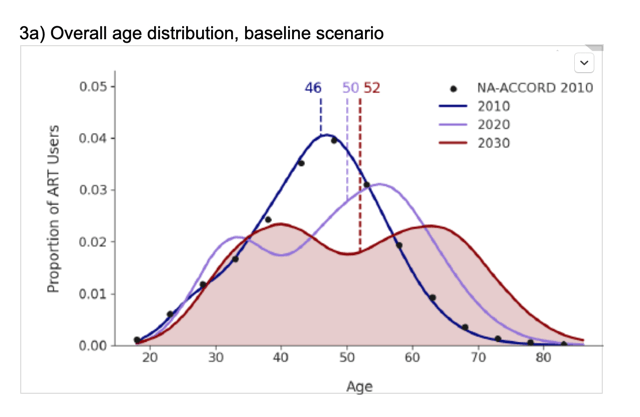
"It is critical to prepare and strengthen HIV care systems to meet the needs of the changing epidemic.....aging HIV population" with diverse needs based on race/ethnicity
Download the PDF
"Bolster HIV Workforce To Meet the Needs of the Aging with HIV Population"....to meet the demographics & Tailor Comorbidity Intervention, Prevention & Care to Specific Sub-groups based on different needs by race/ethnicity
"the projected increase in number of ART-users to >900K by 2030 will likely result in a substantial increase in national spending on ART (estimated at $420,285 life time discounted costs in 2019 or $22.5 billion annual undiscounted in 2018) and additional costs associated with treating HIV comorbidities and preventing falls and frailty"
The PEARL model was used to project the age distribution of PWH using ART in each of the 15 subgroups from 2020-2030. The baseline scenario represents the expected trends in future number of new HIV diagnoses in the absence of additional interventions. The Ending the HIV Epidemic goal to reduce the number of new HIV diagnoses by
75% to 2025 is an ambitious, but a much-needed target to reduce the long-term burden of HIV in the US. However, without a cure, the HIV epidemic will sustain among populations infected with HIV for decades to come. Our modeling results suggest that without a substantial decrease in HIV incidence, a gradual increase in number of ART-users to >900K by 2030. Along with projected increase in median age of ART-users, these individuals are likely to experience an increased burden of comorbidities. It is critical to prepare and strengthen HIV care systems to meet the needs of the changing epidemic, including strategies for long-term viral suppression, ensuring uninterrupted access to ART and prevention and care for comorbid conditions that will likely grow in burden among this aging population.
- Our results suggest an increase in proportion of older ART-users over time, with 54% of the population age ≥50y and 23% age ≥65y by 2030 (34% >60y).
- The overall median age of ART-users is projected to increase from 50y [50y - 50y] in 2020 to 52y [51y - 52y] in 2030 (Figure 3a): 28% white, 28% Hispanic, 44% Black.
- It is critical to prepare and strengthen HIV care systems to meet the needs of the changing epidemic, including strategies for long-term viral suppression, ensuring uninterrupted access to ART and prevention and care for comorbid conditions that will likely grow in burden among this aging population.
- New interventions aiming to increase the effectiveness of comorbidity prevention among PWH are likely to be cost-effective (and even cost-saving) over the next decade.
see continuation below
-------------------------------------------------
this study published in AIDS journal Nov 8 2021 was from the study presented at CROI 2021:
Multimorbidity in people with HIV using ART in the US: Projections to 2030 - (03/08/21)
The largest increase in number of cases of mutimorbidty will be in MSM, the highest increase in prevalence will be in heterosexual women [24%] & men who inject drugs [17%]. See graph below. Women have highest prevalence. This is an UNDERESTIMATE because only PLWH in care were included & the CDC reports 40% of HIV+ in USA have detectable viral load; and this study does not include ART-naive PLWH; data does not include nor trans/bisexual subpopulations. This is an underestimate because the CDC estimated 40% of HIV+ in the USA have detectable viral load and they are NOT included in this dataset. Also detectable viral load is associated with higher risk for comorbidties & mortality.
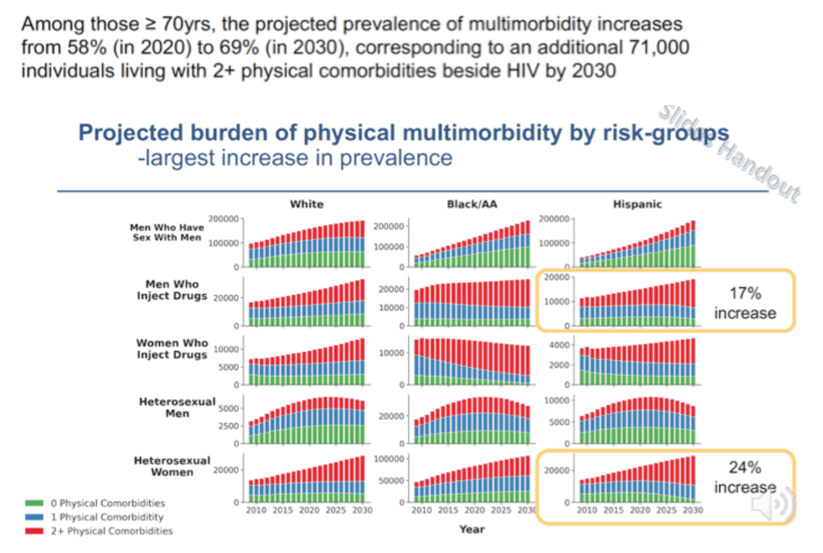
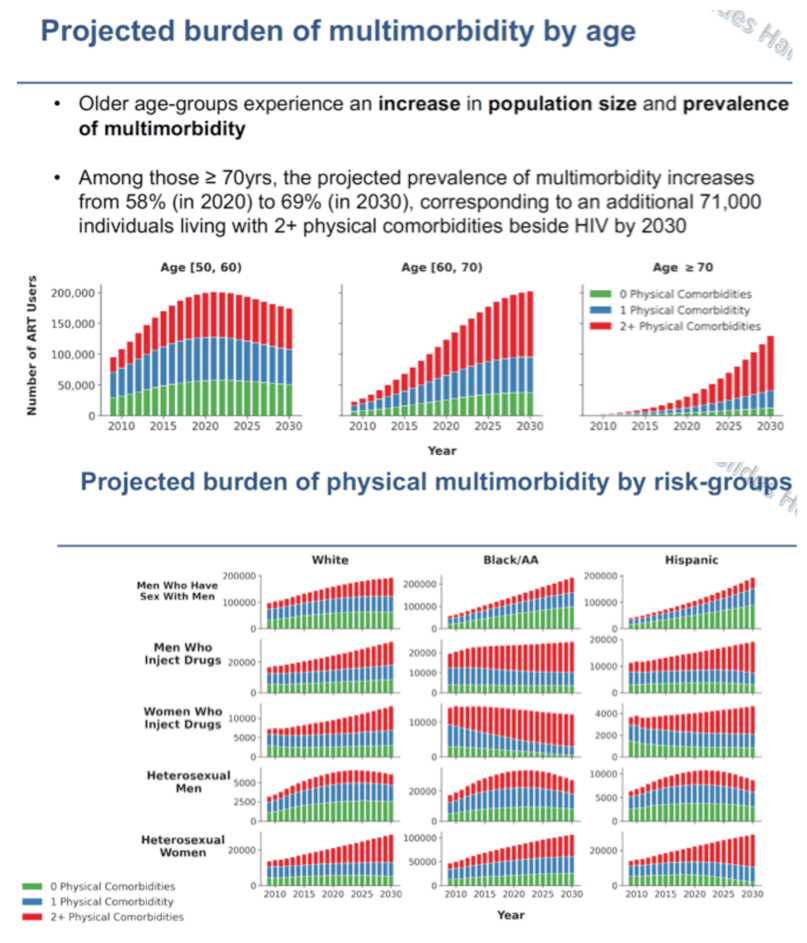
--------------------------------------------------
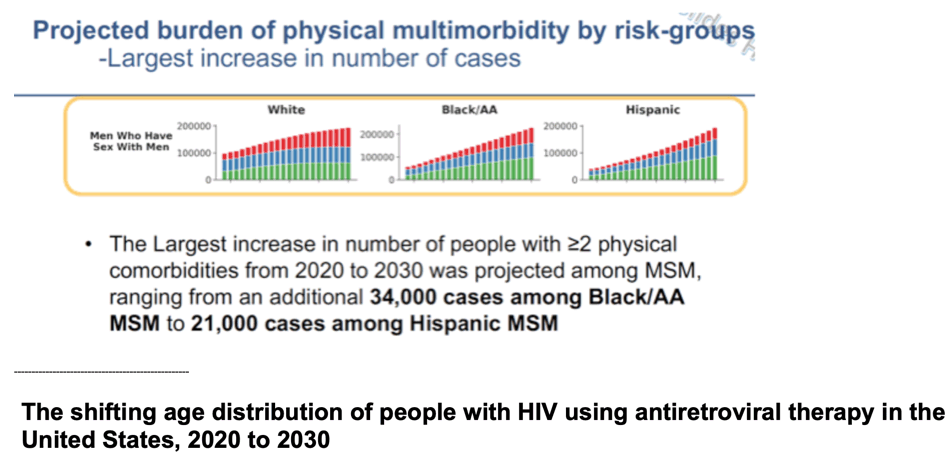
"It is critical to prepare and strengthen HIV care systems to meet the needs of the changing epidemic.....aging HIV population" with diverse needs based on race/ethnicity
"Bolster HIV Workforce To Meet the Needs of the Aging with HIV Population"....to meet the demographics & Tailor Comorbidity Intervention, Prevention & Care to Specific Sub-groups based on different needs by race/ethnicity
The PEARL model was used to project the age distribution of PWH using ART in each of the 15 subgroups from 2020-2030. The baseline scenario represents the expected trends in future number of new HIV diagnoses in the absence of additional interventions. The Ending the HIV Epidemic goal to reduce the number of new HIV diagnoses by
75% to 2025 is an ambitious, but a much-needed target to reduce the long-term burden of HIV in the US. However, without a cure, the HIV epidemic will sustain among populations infected with HIV for decades to come. Our modeling results suggest that without a substantial decrease in HIV incidence, a gradual increase in number of ART-users to >900K by 2030. Along with projected increase in median age of ART-users, these individuals are likely to experience an increased burden of comorbidities. It is critical to prepare and strengthen HIV care systems to meet the needs of the changing epidemic, including strategies for long-term viral suppression, ensuring uninterrupted access to ART and prevention and care for comorbid conditions that will likely grow in burden among this aging population.
- Our results suggest an increase in proportion of older ART-users over time, with 54% of the population age ≥50y and 23% age ≥65y by 2030 (34% >60y).
- The overall median age of ART-users is projected to increase from 50y [50y - 50y] in 2020 to 52y [51y - 52y] in 2030 (Figure 3a): 28% white, 28% Hispanic, 44% Black.
- It is critical to prepare and strengthen HIV care systems to meet the needs of the changing epidemic, including strategies for long-term viral suppression, ensuring uninterrupted access to ART and prevention and care for comorbid conditions that will likely grow in burden among this aging population.
- New interventions aiming to increase the effectiveness of comorbidity prevention among PWH are likely to be cost-effective (and even cost-saving) over the next decade.
The difference in our projected age distributions of ART-users by sex, HIV acquisition risk and race/ethnicity over the next decade further suggests the need for tailoring future comorbidity prevention programs to the needs of specific subgroups, ensuring the most effective intervention meets the most appropriate subgroup at the right time.28 Significant challenges exist to bolster the current HIV workforce to meet the growing needs of populations aging with HIV who require further expertise to manage multimorbidity.29,30
The population size of ART-users projected by PEARL increased over time, reaching a total of 909,638 [878,449 - 946,513] ART-users by 2030, with 23% of this population age ≥65y. The projected proportion of ART-users who are Black/AA remains stable at 45% in 2020 and 44% in 2030. A reduction in the proportion of White ART-users (32% in 2020 to 28% in 2030) was projected, as well as an increase in the proportion of Hispanic ART-users (23% in 2020 to 28% in 2030) over the next decade (Table 1). In 2030, MSM will account for the largest subgroup of ART-users at 64%, followed by heterosexual women at 19%. The proportion of IDU men and women using ART is projected to decline from 9% to 7%, and from 4% to 3% from 2020-2030, respectively.
Adults aging with HIV experience a high burden of age-related comorbidities, which may be reduced with comorbidity prevention and treatment interventions.20-26 Existing heterogeneities in burden of type-specific comorbidities by race/ethnicity suggest the need for tailoring of existing interventions. For example, preventing hypertension in Black/AA men with HIV, who have high rates of hypertension, may result in a greater reduction in overall comorbidity burden as compared to the same interventions in non-Black women, who have lower rates of hypertension.27
Figure 3a-d: Projected age distributions, overall and among subgroups, of people with HIV using ART in the United States in 2010, 2020, and 2030 in the baseline scenario (panels a & b) and after simulating a 75% reduction in new HIV diagnoses from 2020-2025 (EHE75% - panels c & d). Median age in 2010, 2020 and 2030 is shown in blue, purple and red respectively. The area under 2030's age distribution is shaded in red for better visibility. Black dots reflect observed data from the NA-ACCORD in year 2010, and colored lines reflect projections from the PEARL model.
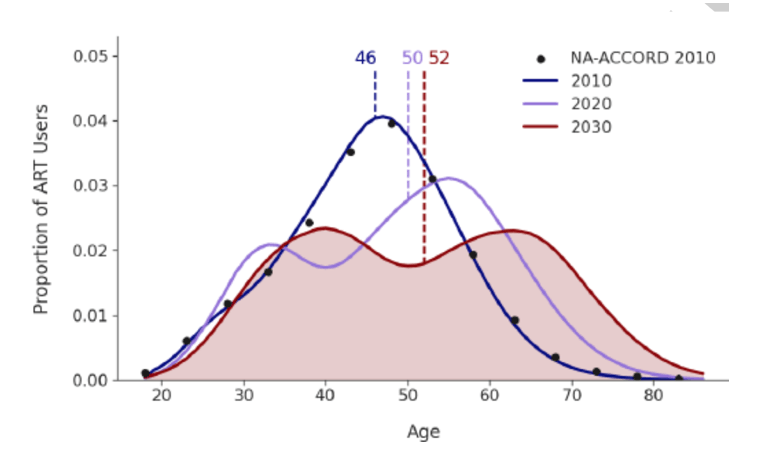
Our results suggest an increase in proportion of older ART-users over time, with 54% of the population age ≥50y and 23% age ≥65y by 2030. New interventions aiming to increase the effectiveness of comorbidity prevention among PWH are likely to be cost-effective (and even cost-saving) over the next decade. Along with projected increase in median age of ART-users, these individuals are likely to experience an increased burden of comorbidities. It is critical to prepare and strengthen HIV care systems to meet the needs of the changing epidemic, including strategies for long-term viral suppression, ensuring uninterrupted access to ART and prevention and care for comorbid conditions that will likely grow in burden among this aging population.
The difference in our projected age distributions of ART-users by sex, HIV acquisition risk and race/ethnicity over the next decade further suggests the need for tailoring future comorbidity prevention programs to the needs of specific subgroups, ensuring the most effective intervention meets the most appropriate subgroup at the right time.28 Significant challenges exist to bolster the current HIV workforce to meet the growing needs of populations aging with HIV who require further expertise to manage multimorbidity.29,30 In terms of cost, the projected increase in number of ART-users to >900K by 2030 will likely result in a substantial increase in national spending on ART (estimated at $420,285 life time discounted costs in 2019 or $22.5 billion annual undiscounted in 2018) and additional costs associated with treating HIV comorbidities and preventing falls and frailty.31-33 New interventions aiming to increase the effectiveness of comorbidity prevention among PWH are likely to be cost-effective (and even cost-saving) over the next decade.
The difference in our projected age distributions of ART-users
by sex, HIV acquisition risk and race/ethnicity over the next decade further suggests the need
for tailoring future comorbidity prevention programs to the needs of specific subgroups,
ensuring the most effective intervention meets the most appropriate subgroup at the right
time.28 Significant challenges exist to bolster the current HIV workforce to meet the growing
needs of populations aging with HIV who require further expertise to manage
multimorbidity.29,30 In terms of cost, the projected increase in number of ART-users to >900K
by 2030 will likely result in a substantial increase in national spending on ART (estimated at
$420,285 life time discounted costs in 2019 or $22.5 billion annual undiscounted in 2018)
and additional costs associated with treating HIV comorbidities and preventing falls and
frailty.31-33 New interventions aiming to increase the effectiveness of comorbidity prevention
among PWH are likely to be cost-effective (and even cost-saving) over the next decade.
Our projections are subject to specific limitations. First, given that successful long-
term aging with HIV can only occur in the context of ART (with the rare exception of the
long-term non-progressors), the PEARL model does not include individuals who do not
initiate ART.34 Second, due to low numbers, the PEARL model does not currently include
transgender people, American Native, Native Hawaiian/Native Other Pacific Islander, Asian,
those reporting multiple races/ethnicities, and perinatally-infected individuals; accounting for
6.6% of all PWH in the US in 2019.3 Third, the PEARL model does not model HIV
transmission.

RESULTS
In 2020, we simulated a median population of 670,770 (95% uncertainty range [665,063 - 678,021]) ART-users using PEARL, of whom 32% were White, 45% were Black/AA, 23% were Hispanic, and included 60% MSM, 19% heterosexual women, and 9% IDU men (see Table 1 for point estimates and Table S26 for uncertainty ranges). Validity of the model was confirmed by comparing the observed age distributions of PWH using ART from 2010-2017 in NA-ACCORD with the simulated outcomes, suggesting no significant pattern of bias in projections from the model among 15 subgroups over time (Supplement Section 3.2, table S25 and figure S18, http://links.lww.com/QAD/C393). Furthermore, we detected no relevant differences (>5%) in characteristics of the simulated populations of ART-users and the CDC's report of PWH (not restricted to PWH using ART) in years 2010 and 2018 in the US (Table 1).
Projections under the baseline scenario
A relatively stable number of ART-initiators was projected over time using PEARL, from 32,934 [31,890 - 34,141] in 2020 to 33,044 [28,696 - 38,085] in 2030. From 2020 to 2030, White MSM experience the largest reduction of 49% in number of ART initiators (from 5,738 [5,231 - 6,251] to 2,907 [1,062 - 4,904]), while Hispanic MSM experience the largest increase of 43% (from 7,498 [6,980 - 8,001] to 10,743 [7,857 - 13,624]), followed by Hispanic IDU women with a 43% increase (136 [93 - 184] to 194 [49 - 345]) and a 41% increase in White IDU women (from 464 [432 - 494] to 654 [545 - 758] (Supplement Section 4.2, table S27, http://links.lww.com/QAD/C393). Projected median ages at ART initiation in 2030 will range from 30y in Black/AA MSM to 55y in White heterosexual men (Figure 2). The projected distribution of age at ART initiation shifts toward younger ages from 2020-2030 among White MSM, White and Hispanic IDU men, and Black/AA heterosexual men, and Hispanic heterosexual women, and remains similar (+/- 2 years) from 2020 to 2030 among Black/AA and Hispanic MSM and Black/AA heterosexual women.
The population size of ART-users projected by PEARL increased over time, reaching a total of 909,638 [878,449 - 946,513] ART-users by 2030, with 23% of this population age ≥65y. The projected proportion of ART-users who are Black/AA remains stable at 45% in 2020 and 44% in 2030. Areduction in the proportion of White ART-users (32% in 2020 to 28% in 2030) was projected, as well as an increase in the proportion of Hispanic ART-users (23% in 2020 to 28% in 2030) over the next decade (Table 1). In 2030, MSM will account for the largest subgroup of ART-users at 64%, followed by heterosexual women at 19%. The proportion of IDU men and women using ART is projected to decline from 9% to 7%, and from 4% to 3% from 2020-2030, respectively.
Despite projected reductions in median age at ART initiation among most subgroups, the overall median age of ART-users is projected to increase from 50y [50y - 50y] in 2020 to 52y [51y - 52y] in 2030 (Figure 3a). This is accompanied by a shift in structure of the age distribution, evolving from a unimodal distribution in 2010 to a bimodal distribution in 2020 (with peaks at 33 and 55 years) and in 2030 (with peaks at 40 and 63 years). After stratifying by subgroup, the projected median age of ART-users decreased by 1 year from 2020 to 2030 among Hispanic MSM and Hispanic IDU men, increased by 1 year among Black/AA MSM and white IDU men and women, by and by 3 years among Black/AA IDU men and Hispanic IDU women; all other subgroups experienced ≥5y increase in median age from 2020-2030 (Figure 3b). In 2030, all but two subgroups (Black/AA and Hispanic MSM) had a median age that was greater than the overall median age of 52 years.
Projections under the EHE75% scenario
Under EHE75% scenario, a gradual reduction in number of ART-initiators over time is projected using PEARL, from 33,058 [32,082 - 34,268] in 2020 to 8,580 [7,503 - 9,849] in 2030. These reductions are modeled similarily among all subgroups. Projected median ages at ART initiation remained stable at 33 [32 - 33] in 2020 to 33 [31 - 34] in 2030.
Achieving EHE75% goals results in subsequent reductions in the number of ART-users in 2030, from 909,638 [878,449 - 946,513] at baseline to 718,348 [703,044 - 737,817] under EHE75% scenario (Figure 4a). The projected reductions are primarily observed among younger individuals (e.g., the number of ART-users age <30y decreases by 70% from 54,206 [46,751 - 61,422] under baseline scenario to 16,263 [13,589 - 18,799] under EHE75% scenario), and were not consistent in magnitude across all 15-subgroups (Table S28). For example, White MSM ART-users experienced a 10% relative decline (from 178,440 [164,452 - 193,405] under baseline scenario to 159,940 [151,954 - 167,447] under EHE75% scenario, Figure 4b), while Black/AA heterosexual women experienced a 16% relative decline (108,412 [100,915 - 116,887] at baseline to 91,240 [86,453 - 95,960] under EHE75% scenario, Figure 4c).
Despite projected changes in size of ART-user subgroups under the EHE75% scenario, we did not project significant differences in the demographic distribution of ART-users in 2030 compared to the baseline scenario (Supplement Section 4.3, table S28, http://links.lww.com/QAD/C393). The overall median age of PWH using ART in 2030 is projected to increase from 52y [51y - 52y] at baseline to 56y [55y - 56y] under EHE75% scenario (Figures 3a, 3c). Similar to the baseline scenario, the EHE75% scenario suggests the emergence of a bimodal age distribution (peaks at 42y and 64y) in 2030. The simulated decline in number of new diagnoses and ART-initiators from 2020 to 2030 under the EHE75% scenario accelerated an increase in median age among all subgroups, corresponding to an increase in projected median age of 5 years among Black/AA and Hispanic MSM, Black/AA and Hispanic IDU men, and White IDU women, 6 years among White IDU men and ≥7y among all other subgroups(Figure 3d). The projected median age among all subgroups except for Black/AA MSM and Hispanic MSM was be greater than the overall median age of 56y in 2030. Detailed comparison of the projected age distributions of ART-users under the baseline and EHE75% scenarios can be found in Supplement Section 4.4, table S29, http://links.lww.com/QAD/C393.
DISCUSSION
We projected a population of 909,638 ART-users (and an additional 32,988
individuals who initiated ART but were subsequently disengaged from ART) in the US by
year 2030 using the PEARL model. Our results suggest a gradual increase in median age
among those on ART, from 46y in 2010, to 50y in 2020, and 52y in 2030. Achieving short-
term EHE's goals for a 75% reduction in new HIV diagnoses from 2020-2025 will reduce
the number of ART-users to 718,348 by 2030 and will accelerate the increase in median age
among ART-users. Significant heterogeneities in size and age distributions of ART-users
were projected in 15 subgroups defined by sex, HIV acquisition risk groups and
race/ethnicity.
Our results suggest an increase in proportion of older ART-users over time, with 54%
of the population age ≥50y and 23% age ≥65y by 2030. CDC reports that 52% of all PWH in
the US were age ≥50y in 2019; this proportion has been increasing by appproximately 2
percentage points annually over the last decade, and the increase has begun to slow down in
recent years.3 The reduction in the median age at ART initiation in the Treat All era can
potentially contribute to the slowed increase in proportion of older adults with HIV in recent
years. Despite a projected increase in the overall median age, two subgroups (Hispanic MSM
and Hispanic IDU men) experienced small (1-year) reductions in median age from 2020-
2030 which can be attributed to the young age at ART initiation (Hispanic MSM) and/or high
sensitivity of these subgroups to variability in the mean age of ART users in 2009 and
dynamicially from 2020 to 2030 (as shown in the sensitivity analysis), driven by the small
sample size observed in the NA-ACCORD of these subgroups.
Projections of size and age distribution of PWH from the PEARL model align with
previous findings/projections in high income countries.18,19 In comparison to HIV
surveillance reports, the projected population of 618,578 ART-users in 2018 is 21% lower
than the CDC's estimate of 779K individuals living with HIV and receiving medical care (as
defined by having ≥1 CD4 or HIV RNA measurement) in 2018.15 Even after accounting for
the 43,134 agents who were disengaged from ART in 2018 (but are not necessarily out of
care) and the 6.6% of PWH3 in racial/ethnic and HIV acquisition subgroups not currently
included in the PEARL model, the adjusted estimate of ART-users in 2018 from the PEARL
model (~7050K) is lower than the CDC's estimate of 779K receiving medical care - as such
our projections of the ART-user population are conservative estimates.
Adults aging with HIV experience a high burden of age-related comorbidities, which
may be reduced with comorbidity prevention and treatment interventions.20-26 Existing
heterogeneities in burden of type-specific comorbidities by race/ethnicity suggest the need for
tailoring of existing interventions. For example, preventing hypertension in Black/AA men
with HIV, who have high rates of hypertension, may result in a greater reduction in overall
comorbidity burden as compared to the same interventions in non-Black women, who have
lower rates of hypertension.27 The difference in our projected age distributions of ART-users
by sex, HIV acquisition risk and race/ethnicity over the next decade further suggests the need
for tailoring future comorbidity prevention programs to the needs of specific subgroups,
ensuring the most effective intervention meets the most appropriate subgroup at the right
time.28 Significant challenges exist to bolster the current HIV workforce to meet the growing
needs of populations aging with HIV who require further expertise to manage
multimorbidity.29,30 In terms of cost, the projected increase in number of ART-users to >900K
by 2030 will likely result in a substantial increase in national spending on ART (estimated at
$420,285 life time discounted costs in 2019 or $22.5 billion annual undiscounted in 2018)
and additional costs associated with treating HIV comorbidities and preventing falls and
frailty.31-33 New interventions aiming to increase the effectiveness of comorbidity prevention
among PWH are likely to be cost-effective (and even cost-saving) over the next decade.
Our projections are subject to specific limitations. First, given that successful long-
term aging with HIV can only occur in the context of ART (with the rare exception of the
long-term non-progressors), the PEARL model does not include individuals who do not
initiate ART.34 Second, due to low numbers, the PEARL model does not currently include
transgender people, American Native, Native Hawaiian/Native Other Pacific Islander, Asian,
those reporting multiple races/ethnicities, and perinatally-infected individuals; accounting for
6.6% of all PWH in the US in 2019.3 Third, the PEARL model does not model HIV
transmission. Our approach to estimating the number of new ART-initiators relies on CDC
estimates of new HIV diagnoses, receipt of HIV care in 1 to 3 months after diagnosis, and
estimates from the ART guidelines that suggest 97% of those presenting for care immediately
initiate ART.[15,34,35] Fourth, the assumption that the current HIV guidelines and present
trends in ART initiation persist to 2030 is inherent in the projections. Fifth, the estimated
functions in of the PEARL model may be affected by the sample size considerations in the
underling NA-ACCORD dataset, as suggested by higher sensitivity of specific subgroups
with small sample size to variation of model parameters. Finally, the experimental simulation
of achieving the EHE75% goal is a simplified representation with a uniform linear 75%
decline over five years in all subgroups; it does not account for non-linear relationships or
anticipated heterogeneities in the decline by subgroups and the impact on other outcomes like
engagement in ART use. While modeling all of these intricacies is important for an in-depth
evaluation of the impact of achieving EHE75%, our goal with our experimental simulation
was to represent an "optimistic" scenario for achieving short-term goals of HIV control in the
US in order to demonstrate that even under such ambitious targets, the US HIV epidemic will
still sustain over several decades.
The Ending the HIV Epidemic goal to reduce the number of new HIV diagnoses by
75% to 2025 is an ambitious, but a much-needed target to reduce the long-term burden of
HIV in the US. However, without a cure, the HIV epidemic will sustain among populations
infected with HIV for decades to come. Our modeling results suggest that without a
substantial decrease in HIV incidence, a gradual increase in number of ART-users to >900K
by 2030. Along with projected increase in median age of ART-users, these individuals are
likely to experience an increased burden of comorbidities. It is critical to prepare and
strengthen HIV care systems to meet the needs of the changing epidemic, including strategies
for long-term viral suppression, ensuring uninterrupted access to ART and prevention and
care for comorbid conditions that will likely grow in burden among this aging population.
|
|
| |
| |
|
|
|